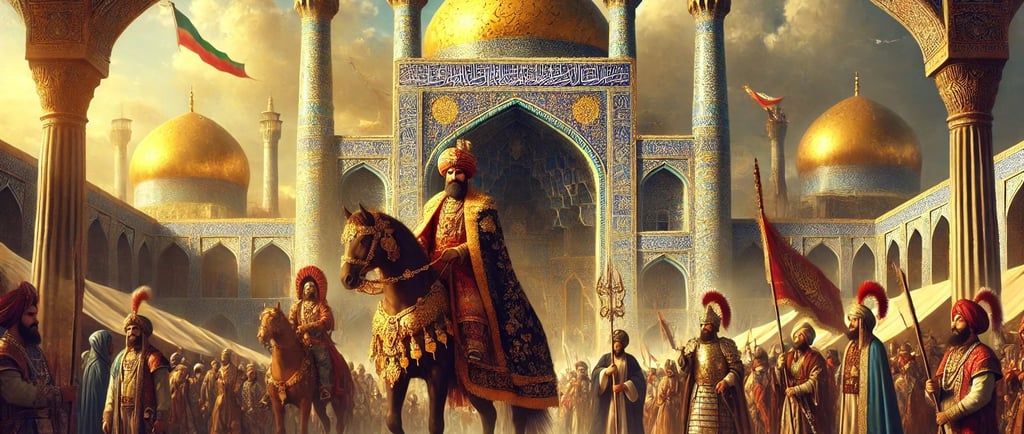The Rise and Fall of the Safavid Empire's Monetary System: A Comprehensive Guide
EDUCATION ON GOLD & SILVER


Introduction to the Safavid Empire and Its Economic Landscape
The Safavid Empire, established in 1501 under the leadership of Shah Ismail I, marked a significant chapter in Iran's history, characterized by a blend of Persian culture and Islamic theology. This empire emerged as a formidable political entity in the early 16th century, evolving from the tribal affiliations of the Safaviyya order, which initially advocated for a unique interpretation of Shia Islam. The Safavid Dynasty claimed divine authority, thereby solidifying its rule across Iran and beyond, incorporating a wide range of ethnic groups, including Persians, Azeris, and Kurds.
The economic foundation of the Safavid Empire was intricately linked to its strategic location along major trade routes. Spanning from the East, connecting with China and India, to the West, linking with Europe and the Ottoman Empire, the empire became a bustling hub for commerce. This integration of various economies fostered not only trade in luxury goods such as textiles and ceramics but also facilitated the introduction of new crops and agricultural practices. The Silk Road, a vital artery for trade, thrived during this period, thus augmenting the empire's wealth and influence.
By the early 17th century, under the rule of Shah Abbas I, the Safavid Empire reached the zenith of its power, showcasing substantial advancements in infrastructure, arts, and trade. Abbas I is renowned for implementing significant reforms, particularly in fiscal policies, which laid the groundwork for the monetary system that would subsequently evolve. The empire enacted regulations that standardized currency and improved tax collection methods, which, in turn, enhanced economic stability. These milestones are essential in understanding the Safavid Empire's multifaceted economic landscape, as they set the stage for the intricate monetary system that played a key role in its eventual rise and decline.
Key Figures Influencing the Safavid Economy
The Safavid Empire, enduring from the early 16th to the mid-18th century, experienced significant economic transformations largely due to the actions of pivotal leaders. Among these, Shah Abbas I stands out as a central figure in reforming the monetary system and promoting commercial activities. Ascending the throne in 1587, he recognized the need for a coherent economic framework to support his aspirations of state expansion and modernization. Shah Abbas I's policies included the effective centralization of power, essential for regulating state finances and currency.
One of his notable reforms was the standardization of currency, which included the introduction of new gold and silver coins that facilitated trade within the vast boundaries of the empire. By improving the consistency of currency, he helped stabilize the economy, fostering a more reliable trading environment. Additionally, Abbas actively promoted trade routes, notably the Silk Road, leading to heightened interaction with foreign merchants, particularly from Europe and Asia, significantly enhancing the empire's wealth.
Alongside Shah Abbas I, the role of state bureaucrats in managing precious metal reserves was paramount. The Safavid state maintained a strong control over silver and gold, essential for the coinage process. Bureaucrats were tasked with overseeing local economies, ensuring that policies benefitted both the state and its subjects. Their interaction with local markets often determined the distribution of wealth and resources, demonstrating the intricate link between bureaucratic policies and economic health during the Safavid period. The policies enacted during this era not only influenced monetary practices but also laid the foundation for economic stability, which persisted for several decades, showcasing the lasting impact of these key figures on the Safavid monetary system.The Role of Precious Metals in the Safavid Monetary System
The Safavid Empire, which reigned from the early 16th to the mid-18th century, established a monetary system heavily reliant on precious metals, notably gold and silver. The decision to choose these metals as the standard for currency was not arbitrary; it stemmed from their intrinsic value, which was widely recognized across different cultures and economies. Gold and silver coins, such as the 'abasi' and 'shahi', were tangible assets that provided a sense of security and stability to both traders and the general populace.
Mining practices in the Safavid era contributed significantly to the availability of these precious metals. The empire sought to control various mining operations to ensure a stable supply of gold and silver, which in turn bolstered trade. The richness of Persian mines, alongside trade relations with neighboring regions, allowed the Safavid economy to flourish. The influx of these metals stimulated commerce and fueled economic activity, making them a cornerstone of the Safavid monetary framework.
However, the values of gold and silver were not static; they experienced fluctuations that mirrored the economic fortunes of the empire. Events such as military conflicts, changes in trade routes, and shifts in demand affected the prices of these metals. During periods of stability, the value of gold and silver often rose, increasing the purchasing power of individuals. Conversely, in times of crisis, the same metals could lose value, leading to economic instability and a reduction in trade volume.
The lessons drawn from the historical reliance on precious metals in the Safavid monetary system are still pertinent today. Precious metals are often viewed as a hedge against inflation and currency devaluation, maintaining a perceived stability that continues to attract investors. The enduring appeal of gold and silver reflects their timeless role as trustworthy assets, resonating with the economic principles that once governed the Safavid Empire.
Lessons from the Safavid Empire's Monetary System: Insights for Today
The Safavid Empire, which rose to prominence in the early modern period, provides valuable lessons regarding the management of a monetary system. The decline of the Safavid monetary structure was significantly influenced by several factors, including the mismanagement of currency and flawed economic policies that ultimately led to rampant inflation and economic instability. These historical events raise critical concerns for contemporary societies that seek to stabilize their own monetary frameworks.
During its height, the Safavid Empire relied heavily on the use of precious metals, particularly silver and gold, to secure the value of their currency. However, as economic pressures mounted, characterized by military expenditures and the costs of governance, the empire resorted to debasing its coins. This practice not only eroded public trust in the currency but also instigated a cycle of inflation that rendered their monetary system ineffective. The mismanagement of currency during this period serves as a stark reminder of the importance of maintaining a sound fiscal policy. Modern economies can glean insights from this historical misstep, emphasizing the necessity of prudent monetary regulation and transparency to avert similar pitfalls.
Furthermore, the Safavid experience highlights the consequences of external factors such as trade dynamics and geopolitical tensions that can impact local economies. In today’s interconnected world, understanding these elements is crucial, as they can significantly influence monetary stability. The contemporary economic landscape further emphasizes the potential advantages of re-evaluating the role of precious metals in securing currency value. The ongoing debates around the efficacy of fiat money could benefit from historical perspectives, wherein the intrinsic value of precious metals served as a stabilizing force. The lessons drawn from the Safavid Empire’s monetary system compel modern societies to critically reassess their own monetary practices and consider integrating historically successful elements to fortify against future instability.
